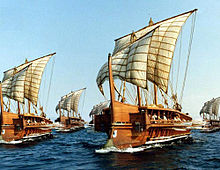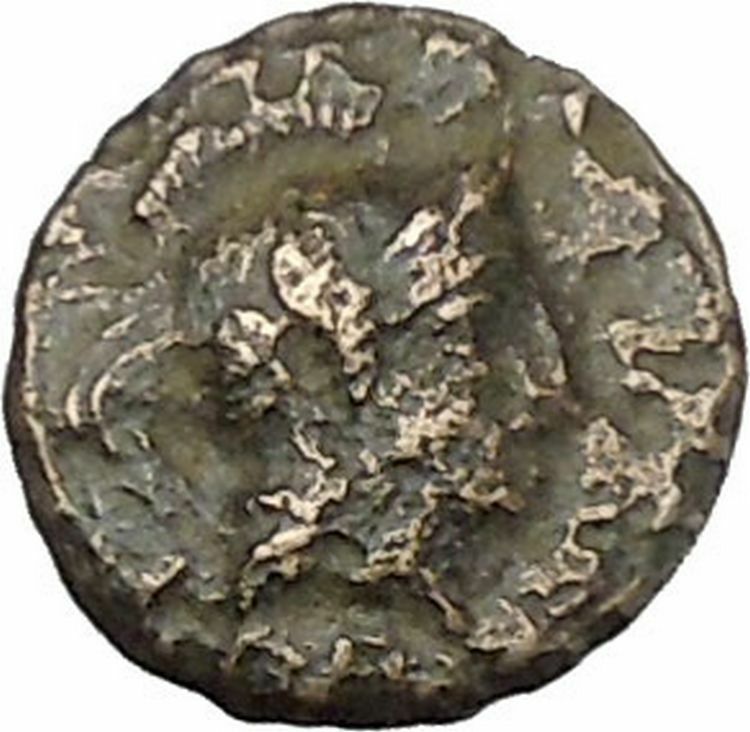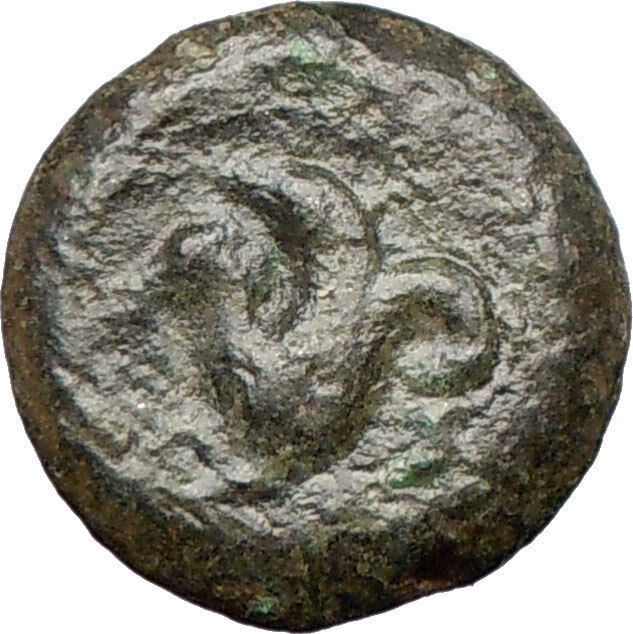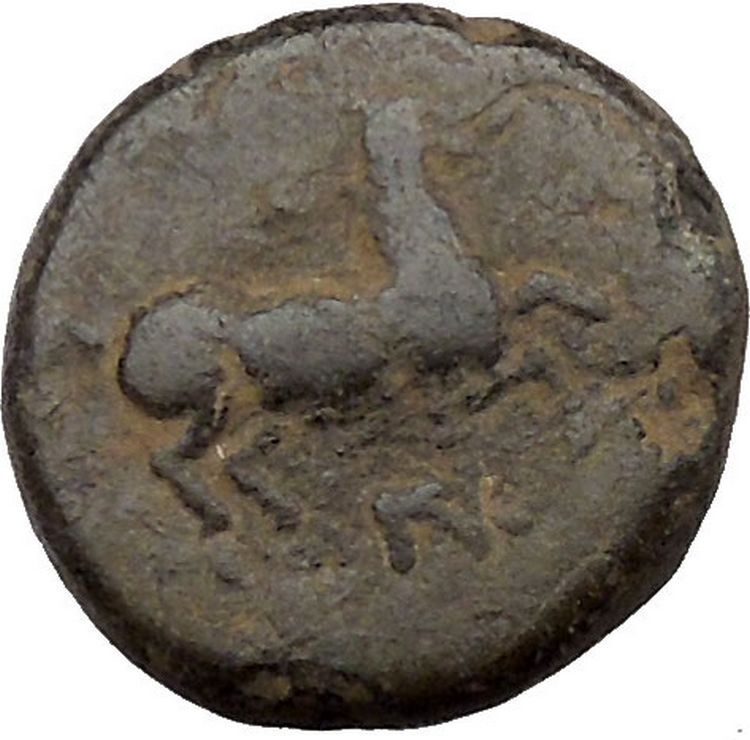|
Greek city of
Tripolis
in
Phoenicia
Bronze 21mm (6.71 grams) Struck circa 1st
Century B.C.
Bust of
Tyche
right; mast of ship behind.
ΤΡΙΠΟΛΙΤΩΝ,
Nike
standing right
on prow of ship, holding wreath and palm; date LHI
to right; star in field to right.
Founded jointly by the three
principal cities of Phoenicia, Tyre, Sidon and
Arados – hence its name – Tripolis was a coastal
town midway between Arados and Byblos.
You are bidding on the exact
item pictured, provided with a Certificate of Authenticity and Lifetime
Guarantee of Authenticity.
Click Here to See all Auction Items for Sale
If you click the above link you will see all auctions I have available for bidding on eBay.
There may be some great deals to be had, so check them out today.
- Greek Low to High & High to low
- Rare Greek, R1, R2, R3, R4
- Roman Republic Page with Easy search by Gens
- Roman Low to High & High to low
- Byzantine Low to High & High to low
- Silver Low to high & High to low
- Gold Low to high & High to low
|
- NGC Low to high & High to low
- NGC Silver Low to high & High to low
- NGC Gold Low to high & High to low
- NGC Greek Low to high & High to low
- NGC Roman Low to high & High to low
- NGC Byzantine Low to high & High to low
|
Tyche (Greek for luck; the Roman equivalent was
Fortuna
)
was the presiding
tutelary deity
that governed the fortune and
prosperity of a city, its destiny. Increasingly during the Hellenistic period, cities had their
own specific iconic version of Tyche, wearing a
mural crown
(a crown like the
walls of the city).

The
Greek historian Polybius
believed that when no cause can be
discovered to events such as floods, droughts, frosts or even in politics, then
the cause of these events may be fairly attributed to Tyche.
Stylianos Spyridakis concisely expressed Tyche’s appeal in a
Hellenistic world of arbitrary violence and unmeaning reverses: “In the
turbulent years of the
Epigoni of Alexander
, an awareness of the
instability of human affairs led people to believe that Tyche, the blind
mistress of Fortune, governed mankind with an inconstancy which explained the
vicissitudes of the time.”
In literature, she might be given various genealogies, as a daughter of
Hermes
and
Aphrodite
, or considered as one of the
Oceanids
, daughters of
Oceanus
and
Tethys
, or of
Zeus. She was connected with
Nemesis
and
Agathos Daimon
(“good spirit”).
She was uniquely venerated at
Itanos
in Crete, as Tyche Protogeneia,
linked with the Athenian
Protogeneia
(“firstborn”), daughter of
Erechtheus
, whose self-sacrifice saved the
city.
She had temples at
Caesarea Maritima
,
Antioch
,
Alexandria
and
Constantinople
. In
Alexandria
the Tychaeon, the temple of
Tyche, was described by
Libanius
as one of the most magnificent of the
entire Hellenistic world.
Tyche appears on many
coins
of the Hellenistic period in the three
centuries before the Christian era, especially from cities in the Aegean.
Unpredictable turns of fortune drive the complicated plotlines of
Hellenistic romances
, such as
Leucippe and Clitophon
or
Daphnis and Chloe
. She experienced a
resurgence in another era of uneasy change, the final days of publicly
sanctioned
Paganism
, between the late-fourth-century
emperors
Julian
and
Theodosius I
who definitively closed the
temples. The effectiveness of her capricious power even achieved respectability
in philosophical circles during that generation, though among poets it was a
commonplace to revile her for a fickle harlot.
In medieval art
, she was depicted as carrying a
cornucopia
, an
emblematic
ship’s rudder, and the
wheel of fortune
, or she may stand on the
wheel, presiding over the entire circle of fate.
The constellation of
Virgo
is sometimes identified as the heavenly
figure of Tyche, as well as other goddesses such as
Demeter
and
Astraea
.
In
Greek mythology
,
Nike was a
goddess
who personified
victory
, also known as the Winged Goddess of
Victory. The Roman equivalent was
Victoria
. Depending upon the time of various
myths, she was described as the daughter of
Pallas
(Titan) and
Styx (Water) and the sister of
Kratos
(Strength),
Bia
(Force), and
Zelus
(Zeal). Nike and her siblings were close
companions of Zeus
, the dominant deity of the
Greek pantheon
. According to classical (later)
myth, Styx brought them to Zeus when

the
god was assembling allies for the
Titan War
against the older deities. Nike
assumed the role of the divine
charioteer
, a role in which she often is
portrayed in Classical Greek art. Nike flew around battlefields rewarding the
victors with glory and fame.
Nike is seen with wings in most statues and paintings. Most other winged
deities in the Greek pantheon had shed their wings by Classical times. Nike is
the goddess of strength, speed, and victory. Nike was a very close acquaintance
of Athena
, and is thought to have stood in
Athena’s outstretched hand in the statue of Athena located in the Parthenon.
Nike is one of the most commonly portrayed figures on Greek coins.
Names stemming from Nike include amongst others:
Nicholas
, Nicola, Nick, Nikolai, Nils, Klaas,
Nicole, Ike, Niki, Nikita, Nika, Niketas, and Nico.

A
galley is a type
of ship
propelled by
rowers
that originated in the eastern
Mediterranean Sea
and was used for
warfare
,
trade
and
piracy
from the first millennium BC. Galleys
dominated
naval warfare
in the Mediterranean from the 8th
century BC until development of advanced sailing warships in the 17th century.
Galleys fought in the wars of
Assyria
, ancient
Phoenicia
,
Greece
,
Carthage
and
Rome
until the 4th century AD. After the fall
of the
Western Roman Empire
galleys formed the
mainstay of the
Byzantine navy
and other navies of successors
of the Roman Empire, as well as new
Muslim
navies. Medieval Mediterranean states,
notably the Italian maritime republics, including
Venice
,
Pisa
,
Genoa
and the
Ottoman Empire
relied on them as the primary
warships of their fleets until the 17th century, when they were gradually
replaced by sailing warships. Galleys continued to be applied in minor roles in
the Mediterranean and the
Baltic Sea
even after the introduction of
steam propelled
ships in the early 19th
century.
The galley engagements at
Actium
and
Lepanto
are among the greatest
naval battles
in history.
Tripolis (Greek:
Τρίπολις;
meaning “three cities”) was a maritime district in
ancient
Phoenicia
. The
center of the confederation of the three Phoenician
cities of
Tyre
,
Sidon
, and
Aradus
. Through the
ages, it evolved to become the present Lebanese city
of
Tripoli
.
History
There is evidence of settlement in Tripoli that
dates back as early as 1400 BCE. In the 9th century
BCE, the
Phoenicians
established a trading station in Tripoli and later,
under
Persian
rule, the
city became the center of a confederation of the
Phoenician city states of
Sidon
,
Tyre
, and
Arados
Island.
Under
Hellenistic
rule,
Tripoli was used as a naval shipyard and the city
enjoyed a period of autonomy. It came under
Roman
rule around
64 BCE. In 551, an earthquake and tidal wave
destroyed the
Byzantine
city of
Tripoli along with other Mediterranean coastal
cities.
During
Umayyad
rule,
Tripoli became a commercial and shipbuilding center.
It achieved semi-independence under
Fatimid
rule, when
it developed into a center of learning. The
Crusaders
laid
siege to the city at the beginning of the 12th
century and were able finally to enter it in 1109.
This caused extensive destruction, including the
burning of Tripoli’s famous library,
Dar al-Ilm
(House
of Knowledge), with its thousands of volumes. During
the Crusaders’ rule the city became the capital of
the
County of Tripoli
.
In 1289, it fell to the
Mamluks
and the old
port part of the city was destroyed. A new inland
city was then built near the old castle. During
Ottoman
rule from
1516 to 1918, it retained its prosperity and
commercial importance. Tripoli and all of Lebanon
was under
French mandate
from
1920 until 1943, when Lebanon achieved independence.
Prehistoric Tripoli (before the 7th century BCE)
Many historians deny the presence of any
Phoenician
civilization in Tripoli before the 8th (or sometimes
4th) century BCE. However, a careful investigation
of the sequence of Phoenician port establishments on
the Lebanese coast will realize a north-to-south
gradient, thus, indicating an earlier age for the
Phoenician Tripoli. As well, the Phoenicians
generally preferred cities that had islands in front
of them, as is the case with Tripoli. In addition,
the proximity of the
Kadisha
(Abou Ali)
river would have been a strong draw to the area.
Tripoli has not been extensively excavated
because the ancient site lies buried beneath the
modern city of
El Mina
. However, a
few accidental finds are now in museums. Excavations
in El Mina revealed skeletal remains of ancient
wolves
,
eels
, and
gazelles
, part of
the ancient southern port quay,
grinding mills
,
different types of columns, wheels, Bows, and a
necropolis
from the
end of the
Hellenistic period
.
A sounding made in the Crusader castle uncovered
Late Bronze Age
,
Iron Age
, in
addition to
Roman
,
Byzantine
, and
Fatimid
remains. At
the
Abou Halka
area (at
the southern entrance of Tripoli) refuges dating to
the early (30,000 years old) and middle
Stone Age
were
uncovered.
Persian Tripoli (from the 6th to the 4th century
BCE)
Tripoli became a financial center and main port
of northern Phoenicia with sea trade (East
Mediterranean and the West), and caravan trade
(North Syria and hinterland).
Hellenic Tripoli (312/311–64 BCE)
Under the
Seleucids
, Tripoli
gained the right to mint its own coins (112 BCE); it
was granted autonomy between 104 and 105, which it
retained until 64 BCE. At the time, Tripoli was a
center of shipbuilding and
cedar
timber trade
(like other Phoenician cities).
Roman and Byzantine Tripoli (from 64 BCE to the 7th
century CE)
During this period, Tripoli witnessed the
construction of important public buildings including
municipal stadium or gymnasium due to strategic
position of the city midway on the imperial coastal
highway leading from
Antioch
to
Ptolemais
. In
addition, Tripoli retained the same configuration of
three distinct and administratively independent
quarters (Aradians,
Sidonians
, and
Tyrians
). The
territory outside the city was divided between the
three quarters.
|












